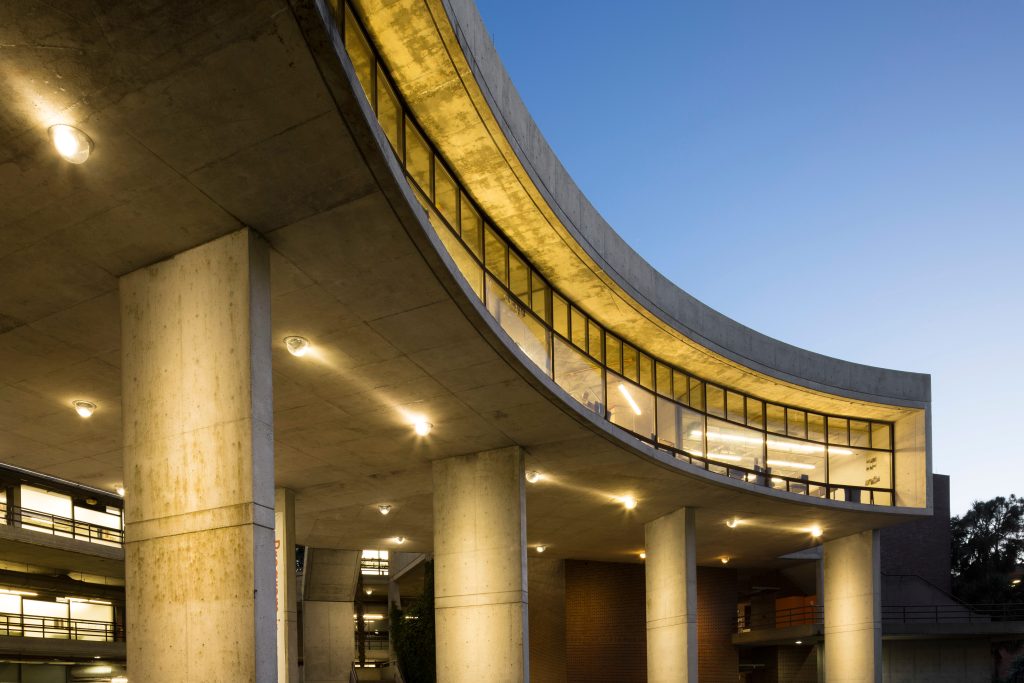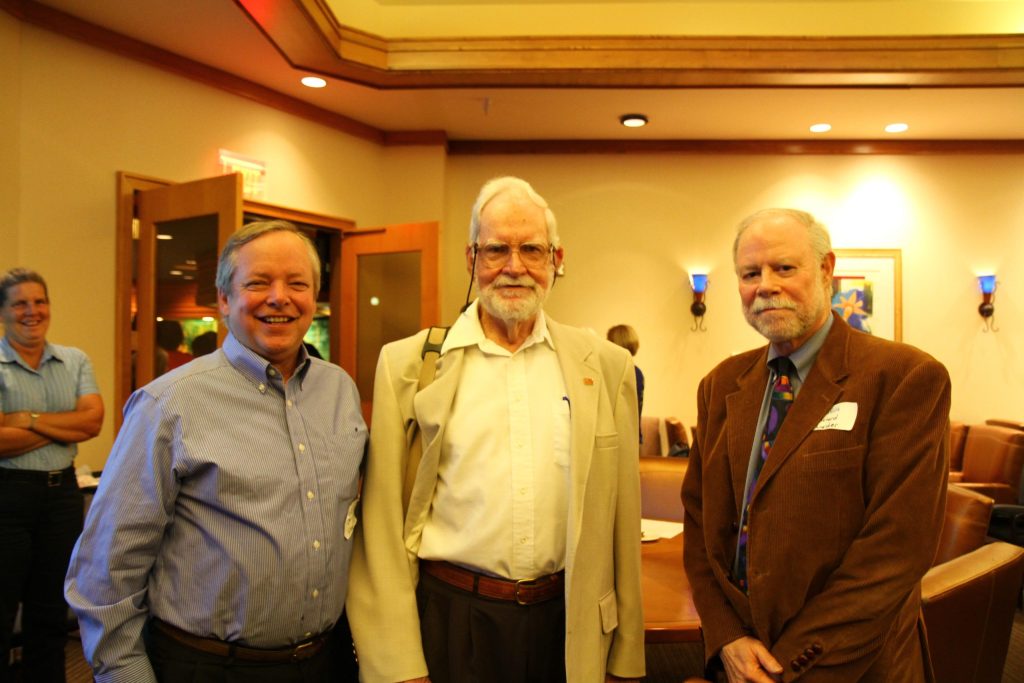50 Years of Success: The Origins of Urban Planning at the University of Florida

Over the last 50 years, the University of Florida’s Urban and Regional Planning department has played a crucial role in shaping the state of Florida, not only by educating and training future leaders in urban development, but also by conducting cutting-edge research that has influenced growth management policy decisions, urban design, and sustainability practices across the state.
The department, established in 1975, grew from a long history of planning education in the state dating back to the 1920’s. In 1927, the university appointed architect Rudolph Weaver to be the first director of the School of Architecture, as well as the lead architect for Florida’s Board of Control, which led construction for all public universities in the state. Trained in architecture and engineering at Drexel University in Philadelphia, Weaver came to Florida following a 20 year career that included designing buildings at the University of Idaho and Washington State.
Within his first year, UF began offering two planning courses focused on landscape design within the College of Agriculture, a program that later moved to the School of Architecture. Soon, additional planning courses were even being offered in the College of Business and the College of Engineering. These courses were similar in construct to ones offered at Harvard and the University of Illinois, which had grown from a landscape architecture curriculum. These courses helped cement the importance of planning education within the constructs of architecture and growth management. Weaver, as Chair of the Gainesville City Plan Board in the 1930’s, often advocated for cities to develop master plans and to regard the planning process as crucial to development regulation and the realization of the “city beautiful”, a concept that prioritizes an increased quality of life through architecture. After Weaver’s death in 1944, one of his closest faculty members, William T. Arnett, would continue his mission to incorporate a strong planning component within the School of Architecture’s offerings.
Under Arnett’s leadership, in 1949, the Department of Architecture began offering a planning option for 5th year students in the Bachelor’s program, as well as a graduate major in Community Planning housed within the MA in Architecture degree. With the establishment of UF’s Department of Planning in 1952, Arnett’s goal was to have a standalone MS in Community Planning.
By 1952, 12 Bachelor students had graduated from the planning track, and four had enrolled in the new graduate degree option. Despite having just four core faculty members during this time, the only universities with a more prominent program were MIT and the University of Pennsylvania. By 1955, the Department of Community Planning became a freestanding department within the School of Architecture and had its own budget. However, in 1958, Arnett was replaced by a new dean. Alongside budget cuts and faculty departures, the department mostly disappeared.
In 1970, architect Arnold Butt began revitalizing the department when he hired Carl Feiss, a planner and architect that was tasked with heading a new urban research institute and developing a basic curriculum in urban studies and planning. Already at UF was urban designer Orjan Wetterqvist, planning consultant Ernest Bartley, urban economist Bill Milliman, and engineer and computer expert John Alexander.
Feiss, with the assistance of these UF experts and faculty members, began significantly pushing for an improvement within the department in the early 1970’s. After making connections across the state through his previous roles in consultancy and development, Feiss expanded the curricular offerings in urban planning and launched the annual Conference on Florida Growth Policy in 1973 to bring together state officials, faculty, and experts to address growth management in Florida.
In 1974, the program had just five courses that were all general in approach and lacking in the technical and analytical skill requirements that would later be a hallmark of the program. However, Feiss and his team of passionate faculty expanded the program so that by 1977, there were 24 course offerings, not including various research opportunities. From design fundamentals to courses on land use regulation and studio classes, the program had become full-fledged and was on the path to accreditation.
The program also expanded beyond the classroom, offering students and faculty opportunities to work on active projects and use their expertise to help communities in need. In 1976, faculty member John Alexander led a student-faculty team to El Progreso in Honduras to develop a recovery plan for a community that was devastated by an earthquake. Another planning studio that year worked with the Chamber of Commerce in Perry, Florida to develop recommendations for improving the appearance and attractiveness of the downtown and address traffic congestion.
In 1977, after growing the program immeasurably and feeling that his job had been done, Feiss announced that architect Earl Starnes would be the first Director of the newly established Department of Urban and Regional Planning. While Starnes had originally met Feiss on a project in the Grand Bahamas, they became more familiar when Starnes, as Florida’s first State Planning Director, attended the annual Florida Growth Policy Conferences put on by Feiss. Starnes, a UF graduate during Bill Arnett’s tenure in the 50’s, had always been an advocate for growth management and the preservation of Florida’s natural landscape – a mindset that he put front and center as he led the new department.
Starnes had worked in Miami for Nims, a firm that became the national architect for the Howard Johnson franchise before going out on his own and forming his own practice alongside his partner Joseph Rensler in Coral Gables. During the 1960’s, he served on the Miami-Dade County Commission and helped implement progressive and environmentally-friendly policies related to development. Eventually becoming the county’s planning commissioner, Starnes was able to infuse the county’s planning process with his support of strong environmental protections.
In 1972, Starnes accepted the position of Director of the Division of Public Transportation with the state and moved to Tallahassee, where he was officially appointed as Florida’s State Planning Director in response to Governor Rubin Askew’s 1972 task force to create a statewide planning system. He served in this role for three years before resigning and taking the director position at UF.
Upon taking the new position, Starnes quickly continued Feiss’s focus on growth within the curriculum, utilizing faculty resources from UF and beyond to create a planning department that could receive the same level of recognition as Florida State University. He brought Ernest Bartley over from political science in order to teach at the department full-time, and used Bill Milliman from economics to fill a hole in the curriculum. By the time Starnes stepped down as Chair in 1989, the department had achieved accreditation and hired a new generation of faculty to continue fostering the principles that the department’s founders had put forward. Starnes continued to teach until 1992, and was named Professor Emeritus in 1993.

Professors Christopher Silver, Earl Starnes, and Richard Schneider
Christopher Silver, FAICP and Professor Emeritus, who served as both Dean of the College of Design, Construction and Planning (DCP) and as Professor in the Department of Urban and Regional Planning (URP), reflected on the origins of the department before his retirement in 2022.
“In the case of Florida, the creation and expansion of programs like urban planning was a response aimed at gaining control over the seemingly out of control process of urban growth that threatened to obliterate the Sunshine State’s cherished natural assets,” said Silver. “Growth management might have been a novel concept in the 1970s, but efforts to plan for and manage urbanization had been a concern in the state since the 1920s.”
“From the moment architect Rudolph Weaver arrived in Gainesville in the mid-1920’s to establish a school of architecture at the University of Florida, an important objective of his was to enlarge the capacity of UF graduates and future practitioners to advance sound city planning as well as good design. Throughout Florida, Weaver preached the necessity for cities to engage in planning, and through his academic leadership, he exposed students to the essentials of contemporary planning practice. His successor, William Arnett, carried this tradition much further by establishing a graduate Community Planning program as its own department within the School of Architecture, and with a small but dedicated faculty cohort.”
“These pioneering efforts infused the UF planning tradition with a solid grounding in urban design, a tradition that continued even after the planning program was no longer organizationally a subunit of architecture. What these early efforts suggest, at least on the surface, is that there was at UF a model of education that embraced equally the design and regulatory functions of planning. It is a tradition worth exploring more fully for the lessons that it holds for planning education and planning practice today.”
Learn more about URP’s 50th Celebration here.